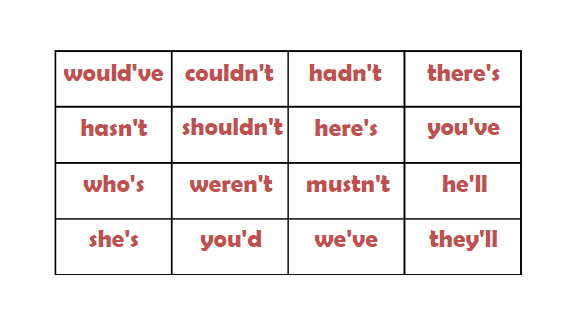English Contractions to Improve English pronunciation

Learning correct pronunciation and use of words in the English language is very important for any English speaker. This is because it promotes effective communication and gives the speaker new found confidence.
Most English speakers are fond of shortening their words when engaging in a conversation with other English speaking persons.
Words that are formed as a result of shortening and combination of two or more words are known as contractions.

The most distinct feature of such words known as contractions is the appearance of apostrophes.
Examples of common words shortened and joined together to form one word are;
- They’d - they would
- Can’t - Cannot
- Won’t - will not
- Mustn’t - must not
- Couldn’t - could not
- Shouldn’t - should not
- Should’ve - should have
- Could’ve - could have
- He’d - he would
- She’d - she would
- Isn’t - is not
- Shan’t - shall not
In reality the use of contractions in written English is not compulsory.
Furthermore, it is even better to use the full number of words, since it is considered appropriate English.
Normally, most writers would prefer to use the full words instead of using shortened words because it is considered grammatically correct.
There are other stylistic writers whose work involves composing poems and songs and other literary works that may use contractions for a stylistic purposes.
These stylistic notions have various advantages specific to the writers’ preference. For example;
Most writers would want their material to be relatable to their readers, to seem friendly and accessible. Use of contractions in this manner may also portray a situation where the writer seems to be talking directly to the readers in a real life situation and not just in fictional writing. This may lead them to want to use contractions in order to pass the message more easily and clearly.
Some English writers while creating fictional characters that they may want to portray as the real life characters may use contractions. In a way this brings the fictional character to life which may relatable to the writer’s audience or readers.
Use of contractions also helps to save space and money when it comes to advertisements. There are many literary works which may prefer the use of contractions since it is short, clear and to the point.
At times the use of contractions may seem contradicting and confusing. Here are a few clarified examples to help you improve in your English speaking skills:
It’s and its English Contractions
The two words are one of the most commonly confused words in the English language.
It is important to differentiate the words in order to communicate in an effective manner.
When pronounced they may not seem very different.
The confusion mostly comes in written works.
It’s is a contraction and a shortened form of it is or it has. Examples in sentences;
- I foresee it’s going to rain on Thursday.
- It’s been a while since I visited the farm.
- It’s just a small cat, it won’t bite.
- It’s his car which got into an accident last week.
The second word ‘its’ is used as a possessive pronoun. It connotes ownership of a thing, object or person. Example;
- The cat carried its kitten in its mouth.
- The car had its lights hit by the pole.
- The dog got its ear cut off because it was infected.
A simple trick for any English speaker and learner to avoid confusion is to use the full version of the words to make sure that the Grammar you are using is correct.
For example, it would be inappropriate to say, ‘The car lost it is headlights in an accident.’ Clearly the car is not a situation being talked about.
The most appropriate words that would be used in this instance to connote ownership would be ‘its.’
Use of contractions in formal writing
As discussed before while the use of contractions may be suited for stylistic writers, it may not be appropriate to use such contractions in formal English writing.
This is because its use tends to portray an informal tone. It is recommended to steer away from the use of contractions in academic research papers, dissertations, formal presentations and other types of formal writings.
However, this should not act as a limitation you can use contractions as and when you feel it is appropriate to use the same.
Another debatable issue is whether to use such contractions at the end of a sentence.
Well, the most appropriate answer would be to look at whether the use of such words may be well understood by the recipient of the message.
Therefore, the discretion is upon the user of the contractions.
Invalid YouTube URL
Learning correct pronunciation and use of words in the English language is very important for any English speaker. This is because it promotes effective communication and gives the speaker new found confidence.
Most English speakers are fond of shortening their words when engaging in a conversation with other English speaking persons.
Words that are formed as a result of shortening and combination of two or more words are known as contractions.

The most distinct feature of such words known as contractions is the appearance of apostrophes.
Examples of common words shortened and joined together to form one word are;
- They’d - they would
- Can’t - Cannot
- Won’t - will not
- Mustn’t - must not
- Couldn’t - could not
- Shouldn’t - should not
- Should’ve - should have
- Could’ve - could have
- He’d - he would
- She’d - she would
- Isn’t - is not
- Shan’t - shall not
In reality the use of contractions in written English is not compulsory.
Furthermore, it is even better to use the full number of words, since it is considered appropriate English.
Normally, most writers would prefer to use the full words instead of using shortened words because it is considered grammatically correct.
There are other stylistic writers whose work involves composing poems and songs and other literary works that may use contractions for a stylistic purposes.
These stylistic notions have various advantages specific to the writers’ preference. For example;
Most writers would want their material to be relatable to their readers, to seem friendly and accessible. Use of contractions in this manner may also portray a situation where the writer seems to be talking directly to the readers in a real life situation and not just in fictional writing. This may lead them to want to use contractions in order to pass the message more easily and clearly.
Some English writers while creating fictional characters that they may want to portray as the real life characters may use contractions. In a way this brings the fictional character to life which may relatable to the writer’s audience or readers.
Use of contractions also helps to save space and money when it comes to advertisements. There are many literary works which may prefer the use of contractions since it is short, clear and to the point.
At times the use of contractions may seem contradicting and confusing. Here are a few clarified examples to help you improve in your English speaking skills:
It’s and its English Contractions
The two words are one of the most commonly confused words in the English language.
It is important to differentiate the words in order to communicate in an effective manner.
When pronounced they may not seem very different.
The confusion mostly comes in written works.
It’s is a contraction and a shortened form of it is or it has. Examples in sentences;
- I foresee it’s going to rain on Thursday.
- It’s been a while since I visited the farm.
- It’s just a small cat, it won’t bite.
- It’s his car which got into an accident last week.
The second word ‘its’ is used as a possessive pronoun. It connotes ownership of a thing, object or person. Example;
- The cat carried its kitten in its mouth.
- The car had its lights hit by the pole.
- The dog got its ear cut off because it was infected.
A simple trick for any English speaker and learner to avoid confusion is to use the full version of the words to make sure that the Grammar you are using is correct.
For example, it would be inappropriate to say, ‘The car lost it is headlights in an accident.’ Clearly the car is not a situation being talked about.
The most appropriate words that would be used in this instance to connote ownership would be ‘its.’
Use of contractions in formal writing
As discussed before while the use of contractions may be suited for stylistic writers, it may not be appropriate to use such contractions in formal English writing.
This is because its use tends to portray an informal tone. It is recommended to steer away from the use of contractions in academic research papers, dissertations, formal presentations and other types of formal writings.
However, this should not act as a limitation you can use contractions as and when you feel it is appropriate to use the same.
Another debatable issue is whether to use such contractions at the end of a sentence.
Well, the most appropriate answer would be to look at whether the use of such words may be well understood by the recipient of the message.
Therefore, the discretion is upon the user of the contractions.
0Comments
Like
Comment
Send
Top Rated Courses
Test Your Skill Set

Do you want to check how much tellented you are? Test your skill here and get certificate.





























 Instagram
Instagram
Comments